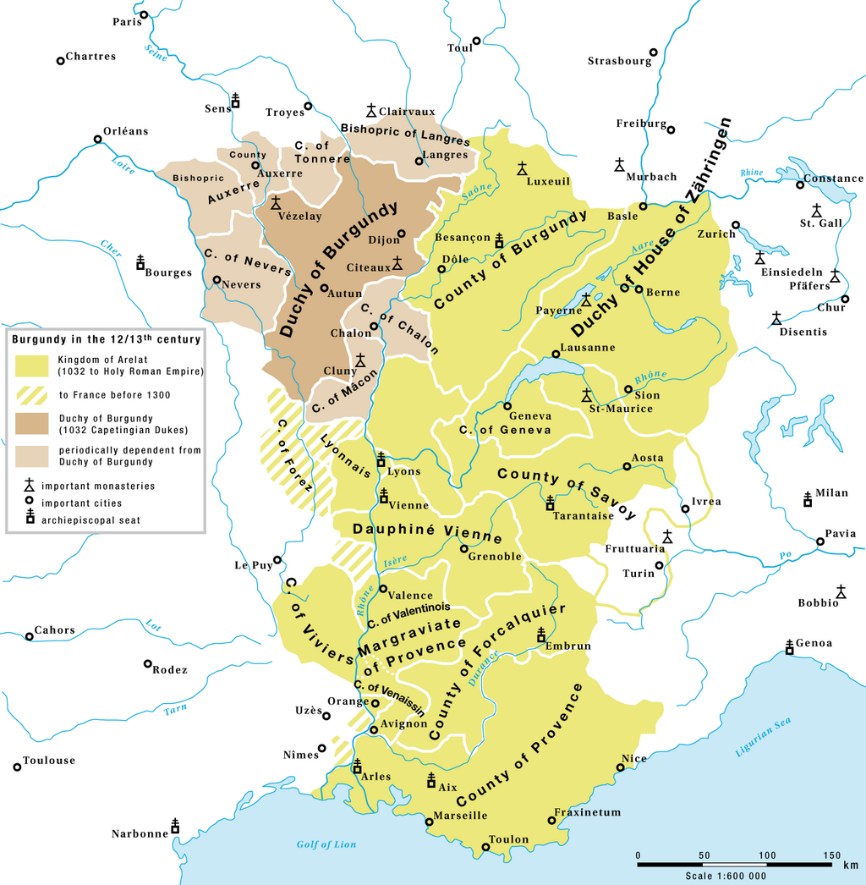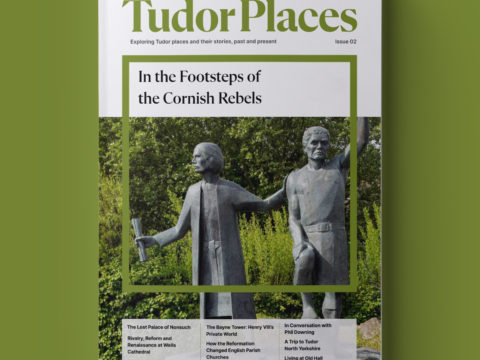The Creation of France
Chapter 4 : Burgundy
Burgundy went through numerous expansions and contractions. By 1037, Burgundy, by then including southern Provence (and Viennois – see below), became part of the territories of Conrad II, Holy Roman Emperor (c. 990 - 1039) (descendant of Ludwig the German). This branch of the Carolingians had also asserted their rights to be overlords of Italy from 962, and the title of king of Italy did not reappear until 1861, in the person of Vittorio Emmanuele II of Savoy.
By 1000, the king of the West Franks was Robert II (c. 972 – 1031), who had total control only over his inherited domains, and varying degrees of influence in the rest of France. Aquitaine and Gascony together far outstripped the French kingdom. His eldest son, Henri (1008 – 1060), became king of the West Franks, and his younger son Robert (1011 – 1076), was granted the dukedom of (Lower) Burgundy (part of the old middle kingdom, recognising the king of the West Franks as overlord) in appanage.
Holding in appanage was a system devised for younger royal sons – the lands were held of the eldest son, and could not be willed away from the original ruler’s descendants. After 1316, when female inheritance to the French throne was barred (see below), appanages returned to the crown on the failure of the male line. This explains why lands held by grant from the French crown after that date did not accept female inheritance, whilst those lands that only gradually came under its control, as overlord or via earlier grants of appanage, did have female rulers.
This grant not include the territories known as the county of Burgundy and the kingdom of Arles, which remained in the sphere of the Holy Roman Emperors.
The Burgundian lands can best be seen in Figure 3.

Duke Robert I of Burgundy’s successors continued to rule the duchy of Burgundy as vassals of France, but were more-or-less autonomous. Meanwhile, the county of Burgundy (also known as Franche-Comté) descended through many generations to Jeanne II, Countess of Burgundy (1291 – 1307), the wife of Philip V of France (1293 – 1322). Their daughter, Jeanne III, Countess of Burgundy (1308 – 1349), married Odo IV, Duke of Burgundy (1295 – 1349), appearing to unite the duchy (French) and county (Imperial).
Joanne and Odo’s grandson, Philip I of Burgundy (1346 – 1361), inherited both the duchy and the county. He married Margaret III, Countess of Artois and Flanders (1350 – 1405), who was the granddaughter of Jeanne III’s sister, Margaret of Burgundy (1310 – 1382). As the couple had no children, the county of Burgundy passed to Margaret of Burgundy, whilst the duchy of Burgundy reverted to the French crown.
The duchy was granted to Philip the Bold (1342 – 1404), son of Jean II of France (1319 – 1364). He married the widowed Margaret III, Countess of Artois and Flanders, and, in due course, she inherited the county of Burgundy from her grandmother. Philip the Bold and Margaret were succeeded in the duchy and the county as well as in Flanders and Artois, by their son, Jean the Fearless (1371 – 1419).
During the Hundred Years’ War, the Burgundians, both dukes and counts, largely supported England.
Jean the Fearless’ son, Philip the Good (1396 – 1467), married Isabella of Portugal (granddaughter of John of Gaunt), and their son, Charles the Bold (1433 – 1477), despite three marriages produced only one living child, Mary of Burgundy (1457 – 1482).
Mary was the greatest heiress in Europe, and, when her father was killed in 1477, there was fierce competition for her hand. Louis XI of France refused to recognise her as duchess of Burgundy and he seized not just the duchy but also the county, as well as Artois and Picardy. Mary’s response was to marry Maximilian, Archduke of Austria, and King of the Romans, by whom she had two children, Philip the Fair (1478- 1506), and Marguerite of Austria (1480 – 1530).
Marguerite was promised to Charles VIII of France, with a dowry consisting of Artois and the county of Burgundy. When he jilted her to marry Anne of Brittany, he was obliged to return the territories. Philip married the heiress to Castile, Juana, and fathered several children, the eldest of whom, the Holy Roman Emperor Charles V (1500 – 1556), waged unceasing war on France, which frequently encroached on the old county of Burgundy territories. The lands were finally ceded to France in 1679, following the Treaty of Nijmegen.
The territories of Flanders, Hainault, Artois and other northern locations along the Franco-Flemish border were absorbed into France in the seventeenth century.
